Yuval Kirstain
VideoJAM: Joint Appearance-Motion Representations for Enhanced Motion Generation in Video Models
Feb 04, 2025Abstract:Despite tremendous recent progress, generative video models still struggle to capture real-world motion, dynamics, and physics. We show that this limitation arises from the conventional pixel reconstruction objective, which biases models toward appearance fidelity at the expense of motion coherence. To address this, we introduce VideoJAM, a novel framework that instills an effective motion prior to video generators, by encouraging the model to learn a joint appearance-motion representation. VideoJAM is composed of two complementary units. During training, we extend the objective to predict both the generated pixels and their corresponding motion from a single learned representation. During inference, we introduce Inner-Guidance, a mechanism that steers the generation toward coherent motion by leveraging the model's own evolving motion prediction as a dynamic guidance signal. Notably, our framework can be applied to any video model with minimal adaptations, requiring no modifications to the training data or scaling of the model. VideoJAM achieves state-of-the-art performance in motion coherence, surpassing highly competitive proprietary models while also enhancing the perceived visual quality of the generations. These findings emphasize that appearance and motion can be complementary and, when effectively integrated, enhance both the visual quality and the coherence of video generation. Project website: https://hila-chefer.github.io/videojam-paper.github.io/
Through-The-Mask: Mask-based Motion Trajectories for Image-to-Video Generation
Jan 06, 2025



Abstract:We consider the task of Image-to-Video (I2V) generation, which involves transforming static images into realistic video sequences based on a textual description. While recent advancements produce photorealistic outputs, they frequently struggle to create videos with accurate and consistent object motion, especially in multi-object scenarios. To address these limitations, we propose a two-stage compositional framework that decomposes I2V generation into: (i) An explicit intermediate representation generation stage, followed by (ii) A video generation stage that is conditioned on this representation. Our key innovation is the introduction of a mask-based motion trajectory as an intermediate representation, that captures both semantic object information and motion, enabling an expressive but compact representation of motion and semantics. To incorporate the learned representation in the second stage, we utilize object-level attention objectives. Specifically, we consider a spatial, per-object, masked-cross attention objective, integrating object-specific prompts into corresponding latent space regions and a masked spatio-temporal self-attention objective, ensuring frame-to-frame consistency for each object. We evaluate our method on challenging benchmarks with multi-object and high-motion scenarios and empirically demonstrate that the proposed method achieves state-of-the-art results in temporal coherence, motion realism, and text-prompt faithfulness. Additionally, we introduce \benchmark, a new challenging benchmark for single-object and multi-object I2V generation, and demonstrate our method's superiority on this benchmark. Project page is available at https://guyyariv.github.io/TTM/.
Movie Gen: A Cast of Media Foundation Models
Oct 17, 2024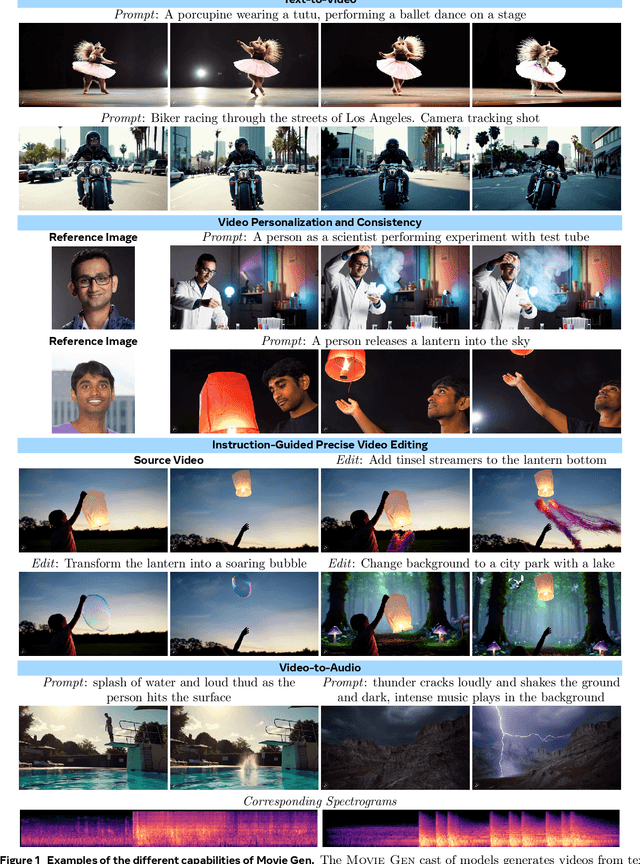

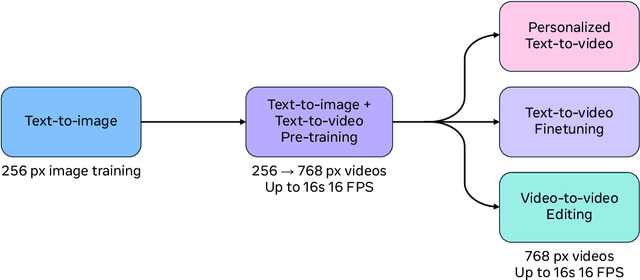
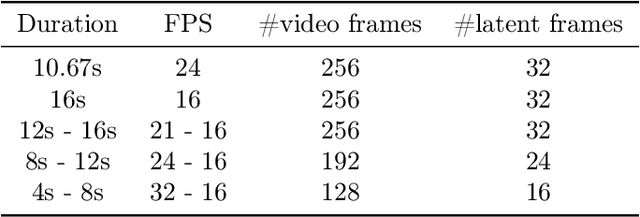
Abstract:We present Movie Gen, a cast of foundation models that generates high-quality, 1080p HD videos with different aspect ratios and synchronized audio. We also show additional capabilities such as precise instruction-based video editing and generation of personalized videos based on a user's image. Our models set a new state-of-the-art on multiple tasks: text-to-video synthesis, video personalization, video editing, video-to-audio generation, and text-to-audio generation. Our largest video generation model is a 30B parameter transformer trained with a maximum context length of 73K video tokens, corresponding to a generated video of 16 seconds at 16 frames-per-second. We show multiple technical innovations and simplifications on the architecture, latent spaces, training objectives and recipes, data curation, evaluation protocols, parallelization techniques, and inference optimizations that allow us to reap the benefits of scaling pre-training data, model size, and training compute for training large scale media generation models. We hope this paper helps the research community to accelerate progress and innovation in media generation models. All videos from this paper are available at https://go.fb.me/MovieGenResearchVideos.
Video Editing via Factorized Diffusion Distillation
Mar 24, 2024Abstract:We introduce Emu Video Edit (EVE), a model that establishes a new state-of-the art in video editing without relying on any supervised video editing data. To develop EVE we separately train an image editing adapter and a video generation adapter, and attach both to the same text-to-image model. Then, to align the adapters towards video editing we introduce a new unsupervised distillation procedure, Factorized Diffusion Distillation. This procedure distills knowledge from one or more teachers simultaneously, without any supervised data. We utilize this procedure to teach EVE to edit videos by jointly distilling knowledge to (i) precisely edit each individual frame from the image editing adapter, and (ii) ensure temporal consistency among the edited frames using the video generation adapter. Finally, to demonstrate the potential of our approach in unlocking other capabilities, we align additional combinations of adapters
Emu Edit: Precise Image Editing via Recognition and Generation Tasks
Nov 16, 2023



Abstract:Instruction-based image editing holds immense potential for a variety of applications, as it enables users to perform any editing operation using a natural language instruction. However, current models in this domain often struggle with accurately executing user instructions. We present Emu Edit, a multi-task image editing model which sets state-of-the-art results in instruction-based image editing. To develop Emu Edit we train it to multi-task across an unprecedented range of tasks, such as region-based editing, free-form editing, and Computer Vision tasks, all of which are formulated as generative tasks. Additionally, to enhance Emu Edit's multi-task learning abilities, we provide it with learned task embeddings which guide the generation process towards the correct edit type. Both these elements are essential for Emu Edit's outstanding performance. Furthermore, we show that Emu Edit can generalize to new tasks, such as image inpainting, super-resolution, and compositions of editing tasks, with just a few labeled examples. This capability offers a significant advantage in scenarios where high-quality samples are scarce. Lastly, to facilitate a more rigorous and informed assessment of instructable image editing models, we release a new challenging and versatile benchmark that includes seven different image editing tasks.
Pick-a-Pic: An Open Dataset of User Preferences for Text-to-Image Generation
May 02, 2023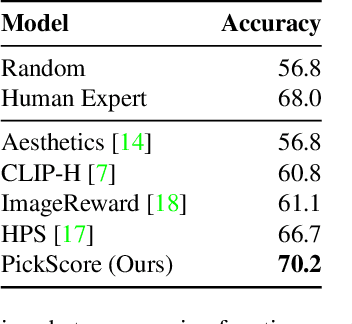
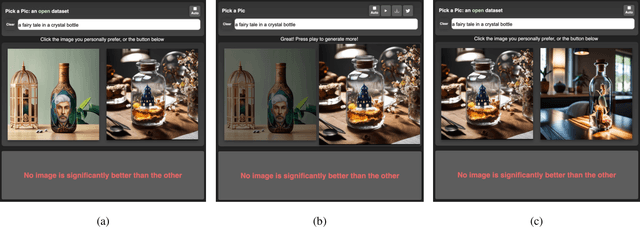
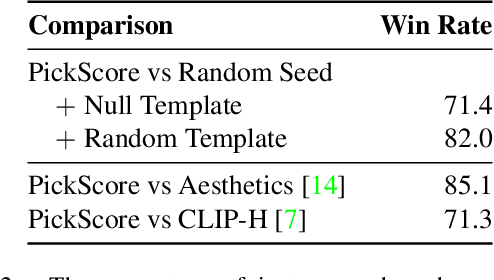

Abstract:The ability to collect a large dataset of human preferences from text-to-image users is usually limited to companies, making such datasets inaccessible to the public. To address this issue, we create a web app that enables text-to-image users to generate images and specify their preferences. Using this web app we build Pick-a-Pic, a large, open dataset of text-to-image prompts and real users' preferences over generated images. We leverage this dataset to train a CLIP-based scoring function, PickScore, which exhibits superhuman performance on the task of predicting human preferences. Then, we test PickScore's ability to perform model evaluation and observe that it correlates better with human rankings than other automatic evaluation metrics. Therefore, we recommend using PickScore for evaluating future text-to-image generation models, and using Pick-a-Pic prompts as a more relevant dataset than MS-COCO. Finally, we demonstrate how PickScore can enhance existing text-to-image models via ranking.
X&Fuse: Fusing Visual Information in Text-to-Image Generation
Mar 02, 2023



Abstract:We introduce X&Fuse, a general approach for conditioning on visual information when generating images from text. We demonstrate the potential of X&Fuse in three different text-to-image generation scenarios. (i) When a bank of images is available, we retrieve and condition on a related image (Retrieve&Fuse), resulting in significant improvements on the MS-COCO benchmark, gaining a state-of-the-art FID score of 6.65 in zero-shot settings. (ii) When cropped-object images are at hand, we utilize them and perform subject-driven generation (Crop&Fuse), outperforming the textual inversion method while being more than x100 faster. (iii) Having oracle access to the image scene (Scene&Fuse), allows us to achieve an FID score of 5.03 on MS-COCO in zero-shot settings. Our experiments indicate that X&Fuse is an effective, easy-to-adapt, simple, and general approach for scenarios in which the model may benefit from additional visual information.
A Few More Examples May Be Worth Billions of Parameters
Oct 08, 2021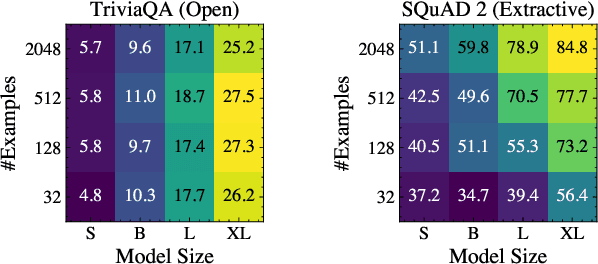

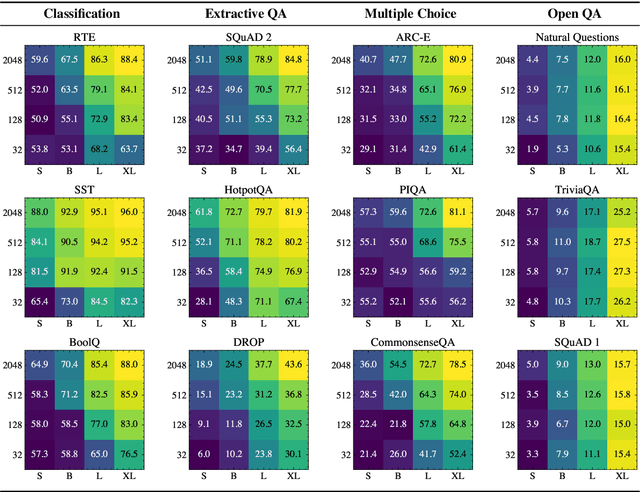
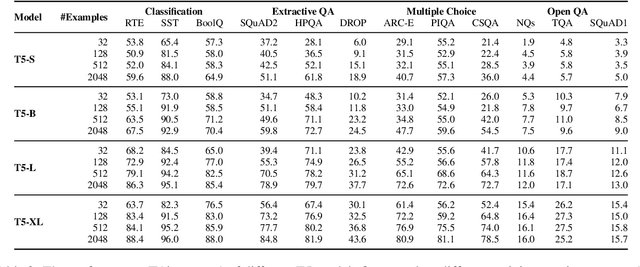
Abstract:We investigate the dynamics of increasing the number of model parameters versus the number of labeled examples across a wide variety of tasks. Our exploration reveals that while scaling parameters consistently yields performance improvements, the contribution of additional examples highly depends on the task's format. Specifically, in open question answering tasks, enlarging the training set does not improve performance. In contrast, classification, extractive question answering, and multiple choice tasks benefit so much from additional examples that collecting a few hundred examples is often "worth" billions of parameters. We hypothesize that unlike open question answering, which involves recalling specific information, solving strategies for tasks with a more restricted output space transfer across examples, and can therefore be learned with small amounts of labeled data.
Few-Shot Question Answering by Pretraining Span Selection
Jan 02, 2021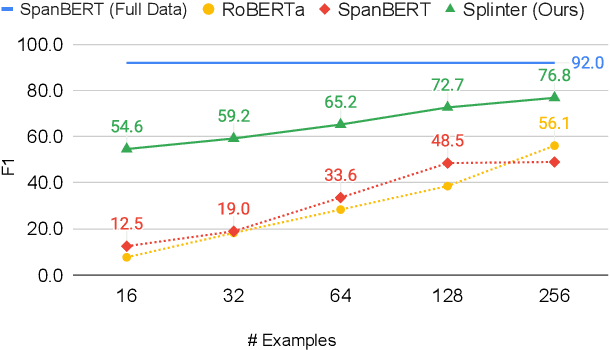
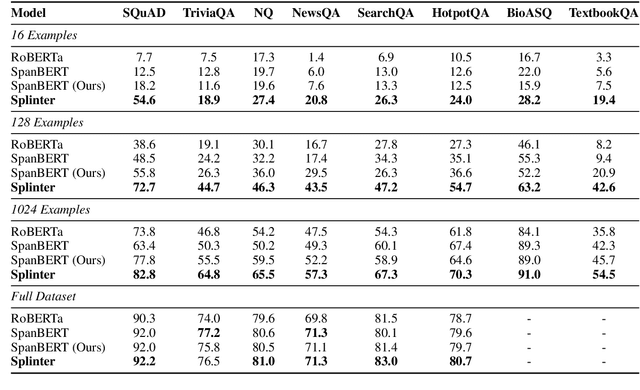

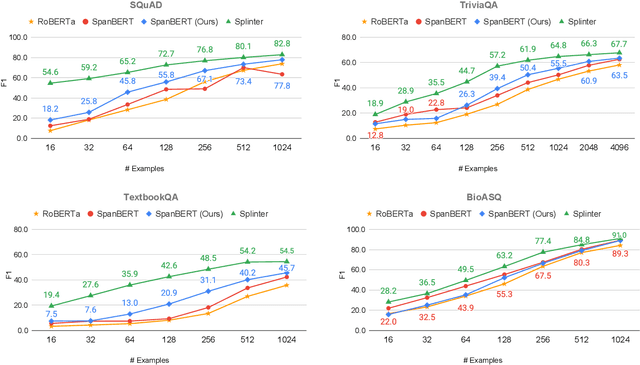
Abstract:In a number of question answering (QA) benchmarks, pretrained models have reached human parity through fine-tuning on an order of 100,000 annotated questions and answers. We explore the more realistic few-shot setting, where only a few hundred training examples are available. We show that standard span selection models perform poorly, highlighting the fact that current pretraining objective are far removed from question answering. To address this, we propose a new pretraining scheme that is more suitable for extractive question answering. Given a passage with multiple sets of recurring spans, we mask in each set all recurring spans but one, and ask the model to select the correct span in the passage for each masked span. Masked spans are replaced with a special token, viewed as a question representation, that is later used during fine-tuning to select the answer span. The resulting model obtains surprisingly good results on multiple benchmarks, e.g., 72.7 F1 with only 128 examples on SQuAD, while maintaining competitive (and sometimes better) performance in the high-resource setting. Our findings indicate that careful design of pretraining schemes and model architecture can have a dramatic effect on performance in the few-shot settings.
Coreference Resolution without Span Representations
Jan 02, 2021
Abstract:Since the introduction of deep pretrained language models, most task-specific NLP models were reduced to simple lightweight layers. An exception to this trend is the challenging task of coreference resolution, where a sophisticated end-to-end model is appended to a pretrained transformer encoder. While highly effective, the model has a very large memory footprint -- primarily due to dynamically-constructed span and span-pair representations -- which hinders the processing of complete documents and the ability to train on multiple instances in a single batch. We introduce a lightweight coreference model that removes the dependency on span representations, handcrafted features, and heuristics. Our model performs competitively with the current end-to-end model, while being simpler and more efficient.
 Add to Chrome
Add to Chrome Add to Firefox
Add to Firefox Add to Edge
Add to Edge